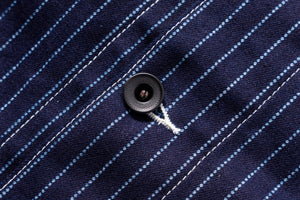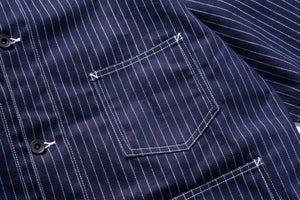The WABASH CHORE COAT was a popular work garment worn by Steam Locomotive crews in the early 20th Century. Its light weight and relative breathability meant it could be used to cover undergarments in hot conditions, such as those found while driving & firing a Steam Train without overheating.





WABASH CHORE COAT
-
Brand
Joe McCoy
-
Style
MJ24014
-
Material
Cotton
-
Color
INDIGO
In the early 1900s, calico fabric surged in popularity, specifically, they were targeted towards railroad workers and labourers. Coinciding with this, 'discharge printing' emerged as a technique in fabric manufacturing. The technique of discharge printing involves dyeing of fabrics, followed by the creation of a repeated stripe dot pattern or polka dot, through a process that removes dye from the fabric via oxidation. By the 1910s, companies were crafting custom prints that showcased railroad logos for employees to buy. Indigo dyeing was a common and popular choice of dye for calico overalls and one that had been brought to America through European settlers. The process of discharge printing on indigo would eventually earn the name “Wabash”.
The term "Wabash fabric" likely originated from its adoption by the Wabash Railroad for uniforms. It became colloquially known as 'Wabash' fabric and was briefly named as such in clothing catalogues from the 1910s. Decades later, when the fabric experienced a revival, it was once again given the moniker 'Wabash.’
The modern chore coat was also a European export and has roots in France, dating back to the 19th century. Traditionally, it features a distinctive boxy silhouette, marked by a patch pocket design and a straight hem.
These French chore coats are often referred to as Blue De Travail, with the name stemming from the rich blue benzoate dye employed to conceal the inevitable dirt and grime accumulated during a day's work. As these coats became integrated into American work culture, they would gradually be known as a chore coat.
The WABASH CHORE COAT has been made from an indigo dyed discharge printed wabash cloth and is finished with bar tack reinforced pockets. The buttons used in this garment, on both the front placket and cuff, are referred to as "Economy Riveted Buttons," which were commonly seen in the 1930s and were custom-made. The fine lines and thinness of the button top, as well as the curvature of the stem, are a testament to the level of craftsmanship that went into their creation.
- Indigo Dyed Discharge Printed Fabric
- Economy Black Oxidised Button
- Cotton Sewing Thread Construction
- Made in Japan
Product Measurements
New Arrivals from Joe McCoy































